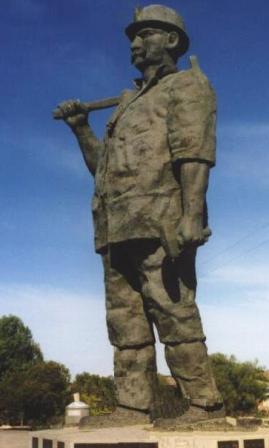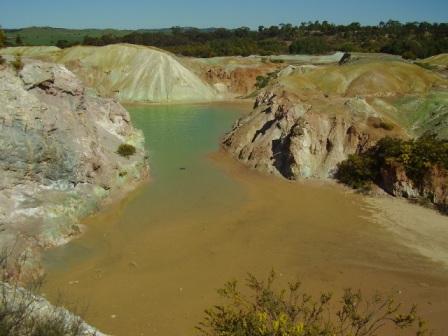| The Cornish Miner, Kapunda 1994 | The Open Mine Workings | |
|---|---|---|
 |
 | |
| Kapunda, South Australia | ||
KAPUNDA SOUTH AUSTRALIA |
|
Kapunda is a town on the Light River near to the Barossa Valley in South Australia. The town has the distinction of being the oldest Copper Mining town in South Australia although it is not the oldest mine.
Significant Copper deposits were first discovered there in 1842 and the town was established around the mine. Initially there was surface mining but soon Cornish mineres arrived to begin tunnelling. Up to ten shafts were dug, including Wheal Bagot, Wheal Charlotte, Wheal Truscott, Wheal Lanyon, Wheal Harris, and Wheal Major (“Wheal” is derived from the Cornish word “huel” = a mine). The shafts have been obliterated by more recent open cut mine workings. By 1850 the mine had reached a depth of 24m and soon after a Cornish Beam Engine was installed which could be used for pumping water plus lifting and crushing ore. Production was high and also farming was developing in the area to support the growing population of miners and their families. In 1860 the Kapunda Mining Company was formed in London. The railway from Gawler to Kapunda was opened on 13th August 1860, making Kapunda the main town in the North of the colony. Kapunda became a hive of industry, with a flour mill, Hawke & Co foundry and engineering, large drapery and grocery shops opened, and Mellor and Cameron building agricultural implements. Bulluck trains were used to transport materials and food North to the Burra mine. Copper was discovered at Wallaroo-Moonta, with potential 4 times greater than that of Burra and up to 20 times greater than Kapunda. As production decreased at Kapunda less costly methods had to be used at the mines. The mine produced copper until it closed 1877-1879. The Kapunda mine closed, because although there was more copper ore available, the quality of the ore dropped, and the price of copper dropped, so it became uneconomical. The machinery was sold to other mines. Kapunda still had a large population of several thousand, and activities turned to farming, manufacturing of farming machinery, the phosphate mine and transport. The railway head at Kapunda meant that all transport further North and East was by bullock teams, but the railway was then continued on to Morgan. In 1880 The Hillside mine opened (50 acres adjacent to the Kapunda mine), and the main mine opened again, continuing to 1912 on a much smaller scale, but it still managed to produce another 12,800 tons of ore. Some miners started farming, others went to Burra Burra (Now called Burra) Mine, others went to the Wallaroo or Moonta Mines. Kapunda produced mining equipment for mines all over Australia, including the famous Cornish boilers, and Kapunda supplied the northern mines with transport and miners. There were also quarries near the town which provided fine marble ranging from dark blue to white. Marble from the Kapunda quarries was used to face Parliament House in Adelaide. Amoung the early Cornish miners were some Hooper families from St Cleer and Calstock in Cornwall. Firstly Robert in the 1850s and then his brothers. William arrived later with his whole family. These are the Hooper Families from Calstock and St Cleer who went to Kapunda. Robert Hooper, who married Catherine Ley 1798 St Cleer, was born in Castock. Robert was the father of Richard Ley Hooper. See Calstock Hooper Families |
RICHARD LEY HOOPER & ANN WILLS m.09.12.1823 St Cleer Tin Miner d.11.10.1857 St Cleer d.11.02.1877 St Cleer Mary 21.11.1824 St Cleer m.William Williams 14.11.1850 St Cleer d.UK Richard Ley 21.05.1826 St Cleer d.1871 Kapunda SA William 06.01.1828 St Cleer m.Elizabeth White 24.12.1850 d.07.09.1881 Kapunda SA Carolina 13.04.1830 St Cleer m.William Stantan 16.06.1853 St Cleer d.1894 UK Robert 21.08.1831 St Cleer m.Mary Ann Rowlett 01.01.1856 Adelaide d.17.08.1881 Kapunda S. Australia Elizabeth Ann 1834 Mary Ann 21.05.1848 St Cleer WILLIAM HOOPER 1828 St Cleer & ELIZABETH WHITE m.24.12.1850 Miner Family went to Kapunda South Australia d.07.09.1881 Kapunda S.Aus d.1890 arrived Adelaide 10.01.1864 Ship Northumberland Richard 01.01.1854 St Cleer m.Sarah Ann Smith ~1876 Australia William 08.04.1855 St Cleer m.Mary Ann Woolcock 06 01.1877 d.1910 Robert John 1857 St Cleer m.Sarah Perry d.1931 Eliza Ann 1859 St Cleer Nelly 1863 d.30.05.1871 Kapunda Edith 23.06.1865 Kapunda SA m.Percy Lionel Withers 21.01.1888 d.1920 ROBERT HOOPER 1831 & MARY ANN ROWLETT m.01.01.1856 Adelaide d.17.08.1881 Kapunda d.03.05.1903 Richard Rowlett 17.12.1856 Kapunda d.1857 Ann Rowlett 12.04.1859 Kapunda m.John C Miller 27.12.1880 d.17.12.1922 Sarah Jane 13.04.1861 Kapunda m.Henry A Daw 01.08.1883 d.22.10.1906 Edwin Robert 01.02.1864 Kapunda m.Naomi O Bowley 23.10.1886 d.30.05.1912 Carolina 29.07.1865 Kapunda m.Alfred Brown 03.08.1887 d.30.08.1912 Mary Jane 12.05.1867 Kapunda m.John Harden 19.05.1886 Louisa 07.05.1869 Kapunda James 21.05.1871 Kapunda m.1)Lillian L Mansfield 01.08.1894 2)Ethel R Fuller 28.09.1915 3)Elsie F.M Hammond 10.04.1920 d.09.07.1924 Lillian Mary 23.05.1873 Kapunda Descendents of these families were born in Australia
There is an enormous statue dedicated to THE CORNISH MINER in the town. This picture was taken of the statue in 1994. Today you can visit and take the heritage trail through the old mines
| The Cornish Miner, Kapunda 1994 | The Open Mine Workings | |
|---|---|---|
 |
 | |
| Kapunda, South Australia | ||